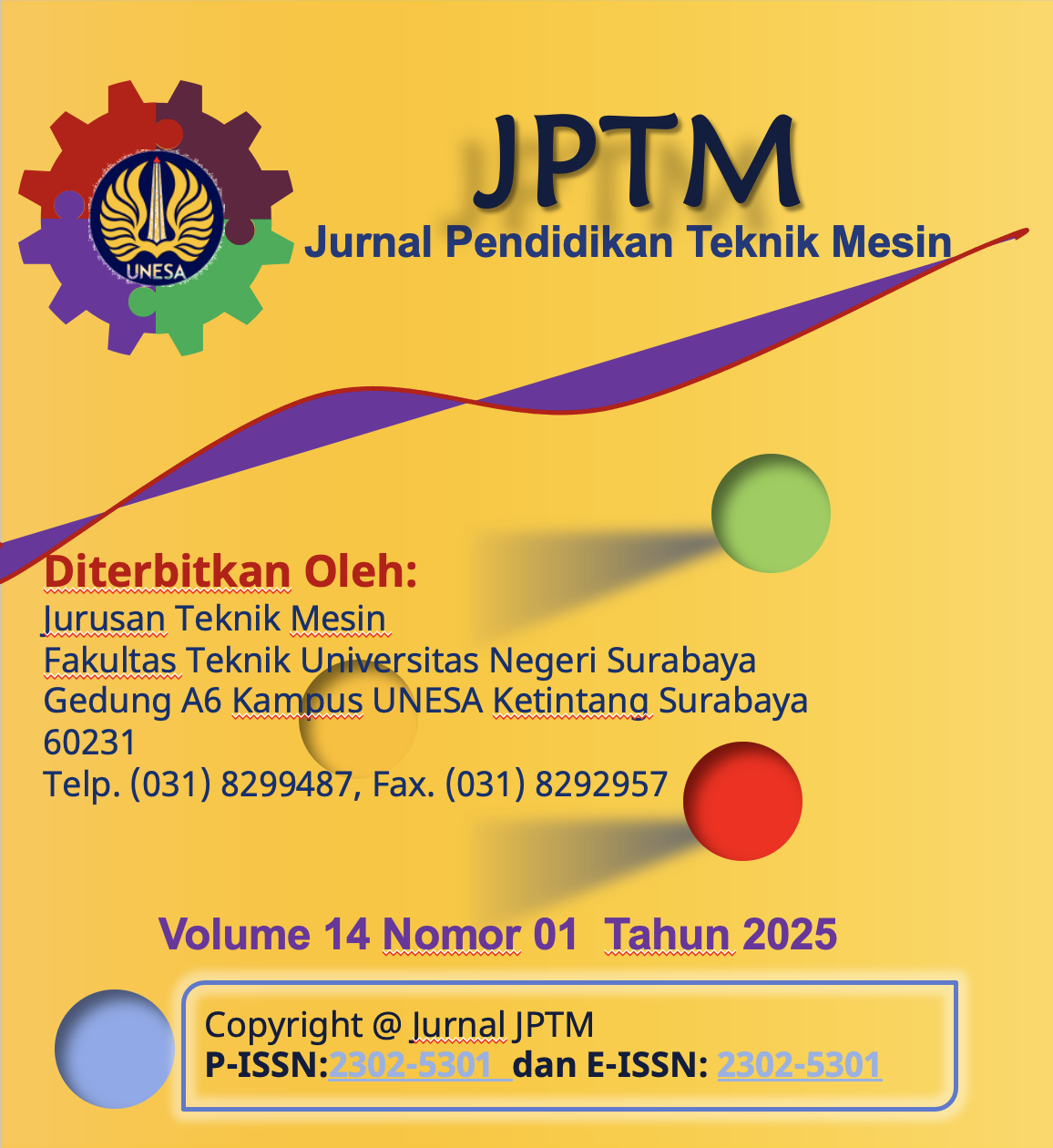P Penerapan Model PjBL untuk Meningkatkan Hasil Belajar Gambar Teknik Manufaktur di SMKN 3 Surabaya
Keywords:
Pembelajaran Berbasis Proyek, Hasil Belajar, Gambar Teknik ManufakturAbstract
This research was motivated by the low learning outcomes of students and the predominant use of conventional teaching methods that failed to foster active student engagement. Many students experienced difficulties in understanding the material, especially in subjects that require practical skills such as Technical Drawing for Manufacturing. Therefore, this study aims to examine the implementation of the Project Based Learning (PjBL) model to improve students’ learning outcomes and technical skills at SMK Negeri 3 Surabaya. The study was conducted over two sessions. In the first session, students performed measurements on actual workpieces using precision measuring tools. In the second session, they created technical drawings based on their measurements using the AutoCAD application. The PjBL model was implemented through six stages: formulating essential questions, designing the project, developing a schedule, monitoring progress, testing the results, and evaluating both the process and the product. The research instruments included pre-test and post-test questions to measure students’ learning progress before and after the application of the PjBL model. The results indicated that prior to the intervention, classical completeness was only 18%. However, after the application of PjBL, post-test scores increased significantly, reaching 94% classical completeness. These findings demonstrate that the PjBL model is effective in improving learning outcomes, technical skills, critical thinking abilities, and students' sense of responsibility in technical drawing activities.
Downloads
References
Yosar. (2019). Penerapan Model PjBL (Project Based Learning) untuk Meningkatkan Hasil Belajar Peserta Didik pada Mata Pelajaran Teknik Pemesinan Kelas XI Jurusan Teknik Mesin SMK Negeri 5 Makassar. Universitas Negeri Makassar.
Jalinus, N., & Nabawi, R. A. (2018). Implementation of the PjBL model to enhance problem solving skill and skill competency of community college student. Jurnal Pendidikan Vokasi, 7(3), 304. https://doi.org/10.21831/jpv.v7i3.14286
Thames, L., & Schaefer, D. (2016). Software-defined Cloud Manufacturing for Industry 4.0. Procedia CIRP, 52,12–17.https://doi.org/10.1016/j.procir.2016.07.041
Aryanto, D. (2021). PENERAPAN MODEL PEMBELAJARAN PROJECT BASED LEARNING (PJBL) UNTUK MENINGKATKAN KEAKTIFAN DAN HASIL BELAJAR SISWA PADA MATA PELAJARAN GAMBAR TEKNIK MANUFAKTUR DI SMKS YPM 7 TARIK SIDOARJO. 99–113.
Sugiyono, D. (2013). Metode penelitian kuantitatif kualitatif dan R&D. In Penerbit Alfabeta.
Sugiyono. (2019). Metodologi Penelitian Kualitatif Kuantitatif Dan R&D.
Fridyana Vira Izzati RM, & Rizki, A. (2017). Implementasi CAD ( Computer Aided Design ) dalam Proses Desain Produk.
Fajri, R. N., Syahril, & Purwantono. (2022). MENINGKATKAN HASIL BELAJAR SISWA DI MATA STUDI GAMBAR TEKNIK MANUFAKTUR KELAS XI TP 1 SMK N 1 SUMATERA BARAT BERSAMAAN PENERAPAN MODEL IMPROVING STUDENT LEARNING OUTCOMES IN MANUFACTURING ENGINEERING IMAGE STUDY CLASS XI TP 1 SMK N 1 WEST SUMATERA TOGETHE. 4(4), 90–97.
Published
Issue
Section
 Abstract views: 118
Abstract views: 118





